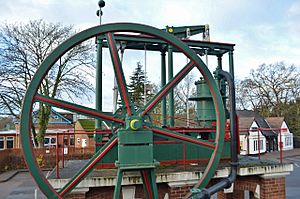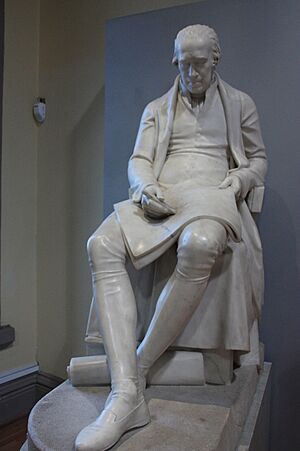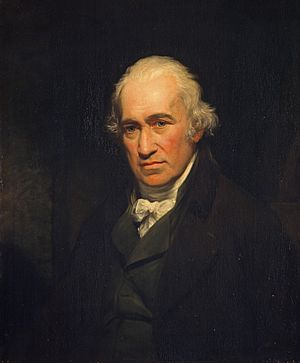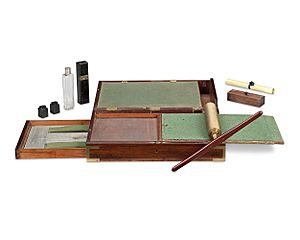James Watt facts for kids
Quick facts for kids
James Watt
FRS FRSE
|
|
|---|---|

Portrait of Watt (1736–1819)
by Carl Frederik von Breda |
|
| Born | 19 January 1736 Greenock, Renfrewshire, Scotland
|
| Died | 25 August 1819 (aged 83) Handsworth, Birmingham, England
|
| Resting place | St. Mary's Church, Handsworth |
| Known for | Watt steam engine Watt's linkage Watt's curve Separate condenser Pneumatic chemistry Butterfly valve Poppet valve Centrifugal governor Horsepower Lap Engine Indicator diagram Letter copying press Rangefinder Resolution (beam engine) Screw-propeller steamer Steam hammer Sun and planet gear |
| Spouse(s) | Margaret Miller (m. 1764–1773 her death) Anne McGrigor (m. 1776) |
| Children | 4 |
| Scientific career | |
| Fields | mechanical engineering |
| Institutions | University of Glasgow Boulton and Watt |
| Influences | Thomas Newcomen Joseph Black Adam Smith John Robison (physicist) John Roebuck James Keir |
| Signature | |
 |
|
James Watt (born January 19, 1736 – died August 25, 1819) was a brilliant Scottish inventor and engineer. He is most famous for his major improvements to the steam engine. His work helped kickstart the Industrial Revolution in Great Britain and around the world. The "watt," which is an international unit of power, is named after him to honor his contributions.
Contents
Early Life and Learning
James Watt was born in Greenock, Scotland, on January 19, 1736. He was the oldest of five children. His mother, Agnes Muirhead, was well-educated. His father, James Watt, was a shipbuilder and owned ships. He also worked as a local official in Greenock.
Watt was taught at home by his mother for a while. Later, he went to Greenock Grammar School. There, he showed a natural talent for mathematics.
After school, Watt worked in his father's businesses. When his father faced money problems, Watt moved to Glasgow. He wanted to find work as a maker of mathematical instruments.
When Watt was 18, his mother passed away, and his father's health declined. Watt traveled to London to train as an instrument maker for a year. In 1756, he returned to Scotland and settled in Glasgow. He hoped to start his own instrument-making business. Because he was young and hadn't finished a full apprenticeship, it was hard for him to get started.
Luckily, the University of Glasgow asked Watt to fix some astronomical instruments. These instruments had been given to the university by Alexander MacFarlane. Three professors then offered Watt a chance to set up a small workshop at the university. This happened in 1757. Two of these professors, the physicist and chemist Joseph Black and the famous economist Adam Smith, became good friends with Watt.
At first, Watt mainly fixed scientific tools for the university. He made and repaired things like reflecting quadrants, parallel rulers, scales, and parts for telescopes and barometers.
In 1759, he teamed up with John Craig, an architect. They made and sold musical instruments and toys. This partnership lasted six years and employed up to 16 workers.
Watt and the Kettle Story
There's a well-known story about James Watt and a boiling kettle. The story says that steam from the kettle made the lid lift, which gave Watt the idea for the steam engine. This story is told in many ways. Sometimes Watt is a young boy, sometimes he's older.
It's important to know that Watt didn't actually invent the steam engine. Steam engines already existed, like the Newcomen engine. What Watt did was make them much, much better. He added a separate condenser, which made the engines work far more efficiently.
Even though it's often called a myth, the kettle story has some truth to it. Watt did many experiments to understand how heat and steam worked. His notes show that he used a kettle as a boiler to create steam during these experiments.
Improving the Steam Engine
While working at the University of Glasgow, Watt became very interested in steam engines. He noticed that the engines of his time wasted a lot of energy. They had to cool down and then reheat their cylinders over and over again.
Watt came up with a brilliant solution: the separate condenser. This new part stopped the energy waste. It made steam engines much more powerful, efficient, and cheaper to run. Later, he changed his engine design to produce a spinning motion. This meant the engine could do more than just pump water; it could power factories and machines.
Watt tried to sell his invention, but he faced many money problems. Things changed when he partnered with Matthew Boulton in 1775. Their company, Boulton and Watt, became very successful.
By 1795, Watt and Boulton opened a new factory called the Soho Foundry. It was built to make their engines. Watt's sons, Gregory and James Jr., became involved in running the business. The company made Watt a very wealthy man.
In 1800, the year Watt retired, his company had built 41 engines.
The Copying Machine
Before 1780, it was hard to make copies of letters or drawings. Watt decided to try a new method. He wanted to transfer ink from an original document onto another sheet. This second sheet would be thin and slightly wet with a special liquid. When pressed against the original, the ink would transfer. The copy would then be held up to the light to read it.
Watt started working on this idea in 1779. It took a lot of experiments, but a year later, he had enough success to get a patent for his process. He kept improving his invention for several more years until it was ready for everyone to use. Watt formed another company with Matthew Boulton (who provided money) and James Keir (who managed the business). This company was called James Watt and Co. It became very popular and was used in offices well into the 20th century.
Later Life and Inventions
Watt continued to invent things even after he mostly retired. He had a special workshop in his home in Handsworth. Here, he created many new machines. One of his inventions was a machine for copying sculptures and medallions. These machines worked very well, but he never patented them. One of the first sculptures he made with this machine was a small head of his old friend, Adam Smith.
James Watt passed away on August 25, 1819, at his home near Handsworth. He was 83 years old. He was buried in the churchyard of St Mary's Church, Handsworth.
Family Life
In 1764, Watt married his cousin, Margaret Miller. They had five children together, but only two lived to adulthood: James Jr. (born 1769) and Margaret (born 1767). His wife Margaret died in 1773 during childbirth.
In 1777, he married again to Ann MacGregor. They had two children: Gregory (born 1777), who became a geologist, and Janet (born 1779). Ann passed away in 1832.
Honors and Recognition

James Watt received many honors during his lifetime.
- In 1784, he became a member of the Royal Society of Edinburgh.
- In 1787, he was elected to the Batavian Society for Experimental Philosophy in the Netherlands.
- In 1789, he joined the special Smeatonian Society of Civil Engineers.
- In 1806, the University of Glasgow gave him an honorary Doctor of Laws degree.
- The French Academy made him a member in 1814.
Memorials and Legacy
Many places and things honor James Watt.
- In his hometown of Greenock, there is a statue and street names dedicated to him.
- The Watt Memorial Library in Greenock started with books Watt donated in 1816. It is now part of the James Watt College.
- Statues of Watt can be found in George Square, Glasgow, Princes Street, Edinburgh, and in Birmingham.
- Heriot-Watt University near Edinburgh is partly named after him.
- Many university buildings, especially in science and technology, are named after Watt.
- Matthew Boulton's home, Soho House, is now a museum that celebrates the work of both Watt and Boulton.
- The Engineering Faculty at the University of Glasgow is in the James Watt Building.
- A large painting called James Watt contemplating the steam engine by James Eckford Lauder is in the National Gallery of Scotland.
- There are statues of Watt in Piccadilly Gardens, Manchester, and City Square, Leeds.
- A huge statue of Watt by Francis Legatt Chantrey is in St Paul's Cathedral. The inscription on it says he "ENLARGED THE RESOURCES OF HIS COUNTRY, INCREASED THE POWER OF MAN, AND ROSE TO AN EMINENT PLACE AMONG THE MOST ILLUSTRIOUS FOLLOWERS OF SCIENCE AND THE REAL BENEFACTORS OF THE WORLD."
- A bust of Watt is in the Hall of Heroes at the National Wallace Monument in Stirling, Scotland.
Interesting Facts About James Watt
- Watt often had poor health as a child and suffered from headaches throughout his life.
- Watt was featured on a £50 note issued by the Bank of England in 2011, along with Matthew Boulton.
- The workshop room Watt used in his retirement was carefully moved and rebuilt. It is now on display at the Science Museum in London as part of an exhibition called "James Watt and our world."
- In 2011, Watt was one of the first seven people to be inducted into the Scottish Engineering Hall of Fame.
Patents
James Watt held six patents for his inventions:
- His first patent (No. 913) was for the separate condenser, which made steam engines much more efficient. This was accepted in 1769.
- Patent 1,244 was for his new method of copying letters, accepted in 1780.
- Patent 1,306 described new ways to create continuous spinning motion, like the sun and planet gear. This was accepted in 1781.
- Patent 1,321 covered improvements to steam engines, including expansive and double-acting features, accepted in 1782.
- Patent 1,432 included more steam engine improvements, like the three-bar motion, accepted in 1782.
- Patent 1,485 was for improved methods of building furnaces, accepted in 1785.
Images for kids
-
The James Watt Memorial College in Greenock.
-
Original condenser by Watt at the Science Museum.
-
The ruin of Watt's cottage workshop at Kinneil House.
-
Cylinder fragment of Watt's first working engine at the Carron Works, Falkirk.
-
Engraving of a 1784 steam engine designed by Boulton and Watt.
-
A steam engine built to James Watt's patent in 1848 in Freiberg, Germany.
-
James Watt's letters from the Science Museum Library & Archives in Wroughton.
-
Scientific tools designed by Boulton and Watt for the Pneumatic Institution in Bristol.
-
An 1835 painting of "Heathfield", Watt's house in Handsworth, by Allen Edward Everitt.
-
Chantrey's statue of James Watt.
See also
 In Spanish: James Watt para niños
In Spanish: James Watt para niños

















